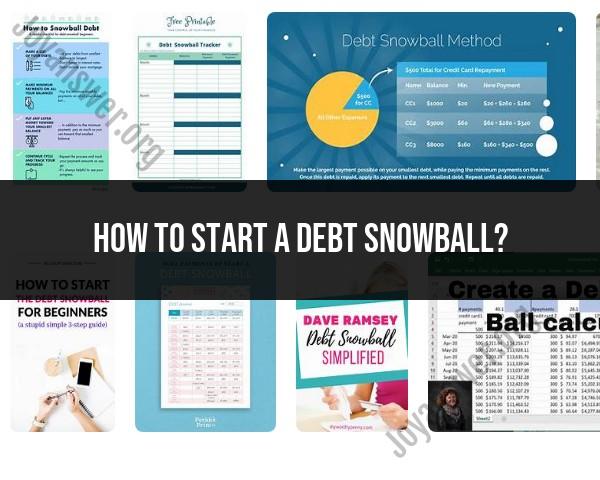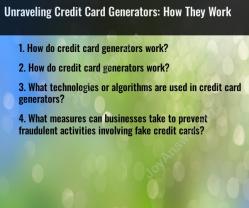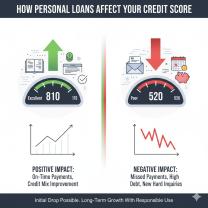How to start a debt snowball?
Starting a debt snowball involves several key steps to set up your plan and begin the process of paying off your debts. Here's a guide on how to initiate your debt snowball method:
Gather Information:
- Collect information on all your debts, including the outstanding balance, interest rates, and minimum monthly payments.
- Compile a comprehensive list that includes credit cards, loans, and any other debts.
Create a Budget:
- Establish a realistic and detailed budget that outlines your monthly income and all expenses.
- Identify areas where you can cut expenses or allocate extra funds toward debt repayment.
Emergency Fund:
- Consider building a small emergency fund to cover unexpected expenses. Having a financial safety net can prevent you from relying on credit cards in emergencies.
List Debts Smallest to Largest:
- Organize your debts in ascending order based on the outstanding balance, from the smallest to the largest.
- Ignore the interest rates for now; the focus is on the total amount owed.
Identify Extra Funds:
- Determine any additional funds you can allocate toward debt repayment. This might involve cutting discretionary spending, finding additional sources of income, or redirecting existing budget items.
Set Clear Goals:
- Establish specific and achievable goals for your debt repayment journey. Define a target date for paying off each debt and an overall timeline for becoming debt-free.
Make Minimum Payments:
- Ensure that you continue making the minimum required payments on all your debts to avoid penalties and late fees.
Start with the Smallest Debt:
- Begin the debt snowball by focusing on the smallest debt on your list.
- Use any extra funds identified in your budget to make additional payments on this smallest debt while maintaining minimum payments on the others.
Track Progress:
- Keep track of your progress using a debt snowball spreadsheet or financial management tool.
- Celebrate small victories as you successfully pay off each debt.
Roll Over Payments:
- Once the smallest debt is paid off, take the total amount you were paying on that debt (including the minimum payment) and apply it to the next smallest debt on your list.
Repeat the Process:
- Continue the process, gradually paying off each debt and rolling over the payments to the next one.
- As you eliminate smaller debts, you'll free up more funds to tackle larger debts.
Stay Committed:
- Maintain discipline and commitment to your debt snowball plan.
- Adjust your budget as needed and stay focused on your financial goals.
By following these steps, you can initiate your debt snowball method and begin the journey toward becoming debt-free. Consistency and dedication to your plan will be key to your success.
Steps to initiate a debt snowball repayment strategy
Here are the steps to initiate a debt snowball repayment strategy:
Preparation:
- Gather your financial data: Collect and organize information for all your debts, including credit card statements, loan documents, and bills. Make a list of each debt, noting its current balance, interest rate, minimum payment, and due date.
- Evaluate your finances: Assess your monthly income and expenses. Analyze your budget to identify areas where you can cut back or allocate additional funds towards debt repayment.
- Calculate your "debt snowball": Determine how much extra money you can consistently dedicate to debt repayment beyond the minimum payments. This is your "snowball fuel" that will accelerate your progress.
Action:
- Rank your debts: Arrange your debts from smallest balance to largest, regardless of interest rate. This is the cornerstone of the snowball method.
- Set up dedicated accounts: Consider opening a separate savings account specifically for your debt snowball payments. This can help you visualize your progress and avoid the temptation to use those funds for other purposes.
- Automate minimum payments: If possible, set up automatic payments for the minimum amounts on all your debts. This ensures you avoid late fees and maintains good credit standing.
- Launch the snowball attack: Prioritize the smallest debt on your list. Allocate your "debt snowball" amount, along with the minimum payment, towards aggressively paying off this debt.
Maintaining Momentum:
- Celebrate milestones: As you pay off each debt, celebrate your accomplishments! This keeps you motivated and reinforces the positive momentum.
- Roll over the freed-up payments: Once you finish paying off a debt, add the minimum payment you were making on it to the minimum payment of the next smallest debt on your list. This significantly increases your snowball's size and speeds up the process.
- Seek out additional resources: Consider side hustles, selling unused items, or negotiating lower bills to bolster your "debt snowball."
- Stay committed: Remember, paying off debt is a marathon, not a sprint. There will be challenges and setbacks. Stay dedicated to your plan, adjust when needed, and don't give up!
Additional Tips:
- Track your progress: Use a debt snowball spreadsheet or app to visualize your balances, payments, and projected payoff dates.
- Prioritize needs over wants: Differentiate between essential expenses and unnecessary spending. Focus on cutting back on unnecessary expenses to maximize your snowball funds.
- Seek support: Discuss your debt snowball plan with trusted friends or family members for accountability and encouragement.
- Adjust as needed: Be flexible and adapt your plan as your financial situation changes.
Remember, the snowball method is just one approach to debt repayment. Consider your financial goals, risk tolerance, and personality when choosing a strategy that best suits you.
I hope these steps help you initiate your debt snowball journey!













